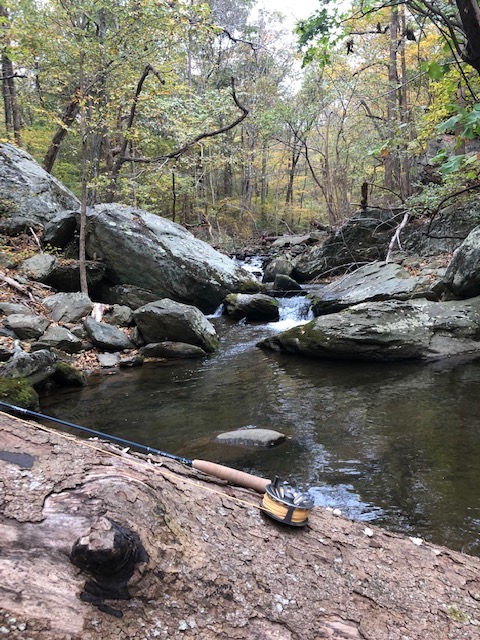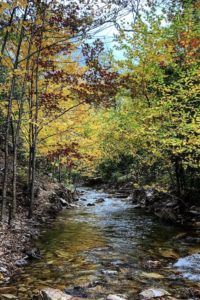Tucked away in the southern Appalachians, North Georgia brook trout streams are waiting to be picked apart by anglers. The state has over 100 miles of wild brook trout streams and with a little bit of work, you can find some great fishing.
Georgia Brook Trout
These are the only native trout to the state and they’re tucked away in the mountains of the northern part of the state. The rest of the state offers some pretty good rainbow and brown trout fishing as well. Especially, in the tailwater of the Chattahoochee.
It’s true that other states have larger populations. However, half the fun of brookie fishing is finding them. That’s where Georgia really beats out the other states.
Finding Georgia Brook Trout
If you’re new to blue lining then welcome to your new evening activity. Browsing paper maps on your dining room table or sitting down and pouring through google maps with a beverage is a pastime of many brook trout anglers.
What to Look for
The easiest thing to do is to use either google maps or pick up a paper map of North Georgia. Grab a highlighter, pen, or pencil and start finding some of the larger rivers in that part of the state. The Soquee, Chattahoochee, Tocoa, or the Hiwassee are great places to start looking.
From there you want to look for headwater tributaries. These small little streams show up as thin blue lines on the map. They can be tough to get to, both from a vehicle and on foot. You’ll need to be prepared to hike and bushwhack a little.
After you’ve found a section of water to fish you’ll need to closely inspect the roads and potential property lines that are around it. Often, you’ll be pulled over on a gravel road and making your way down steep slopes to the river. If your sense of direction isn’t that great then investing in a satellite GPS might be worthwhile.
What Gear do you Need?
You’re going to need to be ready for a hike, and the supplies you bring should reflect that. If your bag has the space then it might be best to wear hiking shoes to the stream and change out once you arrive. This is going to make the hike down much more enjoyable and also keep you safe.
On top of that, a good pair of socks will take you further than you realize. Two pairs if you plan on wet wading. A hiking stick can be useful, but can take up space in your bag and can add on extra weight.
Plan to be out there for most of the day so make sure you have enough food and water to last you the day and a little bit extra. It’s not needed but a lighter is light, doesn’t take up space and can be incredibly useful in a survival situation.
Rod and Reel
Lighter and shorter rods will be your best bet when fishing these streams. Often, you won’t have a whole lot of room for casting or moving. Keep your rods no longer than 7′ 6″ just to be safe. If you know there is more room then you can go all the way up to 9′ if you’re comfortable with it. Make sure to pair the weight of your brook trout reel with the same weight as your rod.
A 3wt should be the heaviest you should use. Anything larger and you’re going to have a difficult time working those smaller flies and it just wont be as much fun reeling in these trout.
Flies
Keep it simple. If there are trout in the stream you’re fishing then chances are they havent seen many other anglers and they’ll hit just about anything. Year round patterns that work great will be parachute adams, elk hair caddis, pheasant tails, hares ear, and san juans.
Wooly buggers can work well too. In the summer when terrestrials are out you can throw some foam betteles, or hoppers.
Make sure to bring more than one of each fly. Theres a good chance you’re going to get hung up and lose at least one fly when your fishing in tight quarters.
Accesories
Net, tippet, nippers, hemostat, floatant, are the essentials you’ll need. I like to keep my gear to a minimum to help reduce weight and these are what I bring. Bring what you feel like you’re going to need though. Next trip you can always take less or add more.
How to Fish these Streams
Wokring your way up stream is often going to be the most effective way. The fish will be facing upstream, so it will be easier to sneak up on pools without being seen.
Work the pool from back to front. Keep your shadow and fly line off of the water. These wild fish may be easier to catch, but they’re very wary. If anything seems off to them they’ll bolt and the pool will be spooked. At that point you’re better off just leaving and moving onto the next one.
Work the pool from side to side back to front. Depending on how large the pool is you should be making 8-10 casts. If you’ve found they’re not taking flies on the first pass then you can increase that number. Be ready for quick strikes. Often it will be only drift for a second or two before a fish will take it.
Practie your roll and bow and arrow casts. It can get very tight in these streams and a traditional back cast will most likely not work. Do your best to land your fly as delicately as possible. Slapping down an adams and creating a large ripple is not going to help your chances to land a fish.
Final Thoughts
Blue lineing for Georgia brook trout can be an absolute blast. You just need to make sure you’ve done all of your prep work. Otherwise, it could be a long and frustrating day out on the water. Did I miss anything above? Anyhting you would like to add about chasing brookies? Comment below!



